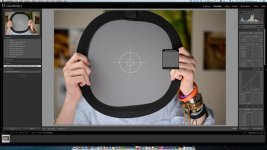Hello everyone!
First post here- seems like a really wonderful community.
So- I've got a few questions about the setup I'm using and I'm wondering if anyone can possibly help?
Shooting with (for these examples) Nikon D800 (bought 14 days ago from Amazon direct), Nikon 50mm f/1.8, 2 softboxes with 5500K lightbulbs and a grey card.
So, I've set up my D800 so that it's white balance is at 5560K, the lights are on the subject, a grey card is shot where his face will be- a series of pictures are taken and bought into lightroom (4).
Now the strange stuff happens- the original photo with the grey card shows having a colour temp at 5350K with +6 tint (as shot). Setting manual white balance by clicking on the grey card sets colour temp to 5450 and tint to -1, neither of those settings are concurrent with what's been set by me on the camera... any idea what's causing the issue?
Also, I've uploaded some of the photos from the set (totally unedited with the exception of changing the white balance by grey-card-clicking and syncing in LR)- I'd particularly appreciate feedback concerning whether or not the skin tones look 'normal' to you. I appreciate that this is subjective, but after having spent so much time looking at these, and comparable shots- I'm finding it hard to determine what 'normal' even is!
DSC_0544.jpg | Flickr - Photo Sharing!
DSC_0546.jpg | Flickr - Photo Sharing!
I would also appreciate some commentary on some video I took (same subject, same location, same lights- no colour correction in post) with the D800- to my eye it looks a little green, but- I can't be sure.
On turning 21 and snow! - YouTube
I'll add that the colour profile I set was 'Camera Standard' NOT Adobe standard.
Like I've said- I'd really, truly appreciate any comments that anyone can offer...
First post here- seems like a really wonderful community.
So- I've got a few questions about the setup I'm using and I'm wondering if anyone can possibly help?
Shooting with (for these examples) Nikon D800 (bought 14 days ago from Amazon direct), Nikon 50mm f/1.8, 2 softboxes with 5500K lightbulbs and a grey card.
So, I've set up my D800 so that it's white balance is at 5560K, the lights are on the subject, a grey card is shot where his face will be- a series of pictures are taken and bought into lightroom (4).
Now the strange stuff happens- the original photo with the grey card shows having a colour temp at 5350K with +6 tint (as shot). Setting manual white balance by clicking on the grey card sets colour temp to 5450 and tint to -1, neither of those settings are concurrent with what's been set by me on the camera... any idea what's causing the issue?
Also, I've uploaded some of the photos from the set (totally unedited with the exception of changing the white balance by grey-card-clicking and syncing in LR)- I'd particularly appreciate feedback concerning whether or not the skin tones look 'normal' to you. I appreciate that this is subjective, but after having spent so much time looking at these, and comparable shots- I'm finding it hard to determine what 'normal' even is!
DSC_0544.jpg | Flickr - Photo Sharing!
DSC_0546.jpg | Flickr - Photo Sharing!
I would also appreciate some commentary on some video I took (same subject, same location, same lights- no colour correction in post) with the D800- to my eye it looks a little green, but- I can't be sure.
On turning 21 and snow! - YouTube
I'll add that the colour profile I set was 'Camera Standard' NOT Adobe standard.
Like I've said- I'd really, truly appreciate any comments that anyone can offer...

